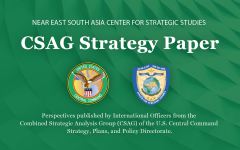Defining ‘Partner of Choice’
September 15, 2021 2021-09-15 15:25Defining ‘Partner of Choice’
By: LCDR Stipe Skelin, HRV Navy, CSAG CCJ5
15 Sep 2021
Introduction:
USCENTCOM applies the term PoC as part of the US strategy to support those who align with the US approach to the region – stability and security, leverage greater influence over key partner nations and other Great Power Competitors. Successful partnerships result in partner nations that are likely to support US diplomatic, informational, military, and economic interests in a region. One of USCENTCOM’s published priorities, “Competition with China and Russia,” is described:
Through stronger MIL–to-MIL relationships, and remaining the security partner of choice, USCENTCOM helps the US maintain its competitive advantage over Russia and China in the region with countries most susceptible to Russian and Chinese malign influence.
Currently, USCENTCOM primarily pursues PoC objectives through security cooperation (SC), foreign military sales (FMS), and access basing and overflight (ABO). No doctrinal definition of PoC exists. However, PoC is commonly used in commercial contexts to describe a similar scope of relationship:
“Partner of choice” describes a long-term partnership in which parties have made a significant investment for their mutual benefits. Such a relationship includes both rational and emotional elements, and focuses less on transactional requirements (i.e. price) and more on guidance and advice.
Within USCENTCOM efforts to become a PoC, include numerous long-term relationships through military institution and capacity building. In recent years however, USCENTCOM appears to center on transactional-type relationships that require key partners to buy ‘US only’ military systems despite US export restrictions and regardless of the partners’ self-determined needs. While still a relationship, the ‘transactional form’ is defined as: “of or relating to an attitude in which personal interaction revolves around cost and benefit.”
This paper examines differences between USCENTCOM’s notion of ‘partnership’ within PoC and the application of PoC through three case studies. By exploring the US’ PoC approach towards key partners, USCENTCOM will avoid SC strategies that do not match organizational intent and prevents overly transactional approaches that may weaken its standing with those nations.
Key Points:
- USCENTCOM applies the term “Partner of Choice” (PoC) as part of the US strategy to leverage greater influence over key partner nations and other Great Power Competitors.
- In Great Power Competition (GPC), the US struggles to build sustainable capacity amongst its partners.
- US efforts have been too transactional in scope, focusing primarily on short-term capability generation (training and equipping), rather than on enduring capacity-building strategies that self-replenish from a deeper reservoir of institutional support.
- There appears to be a difference between USCENTCOM’s notion of ‘partnership’ within PoC and its practice of PoC.
- USCENTCOM’s PoC approach to Egypt, Turkey, and KSA indicate an over reliance on a transactional PoC approach.
- An effective PoC relationship must allow a partner to make its own decisions to serve its self-interest and comply with clearly defined rules.
- GPC is at its core an ideological competition between states. China’s rise and Russia’s resurgence require the US to realign its foreign policy toward strengthening relations and bolstering democratic states. Security assistance is a tool to do so.
- A review and an update of the notion of PoC is required. By doing so, the relationship can step up from a ‘product of choice’ to a true PoC.
The opinions and conclusions expressed herein are those of a number of international officers within the Combined Strategic Analysis Group (CSAG) and do not necessarily reflect the views of United States Central Command, not of the nations represented within the CSAG or any other governmental agency.






